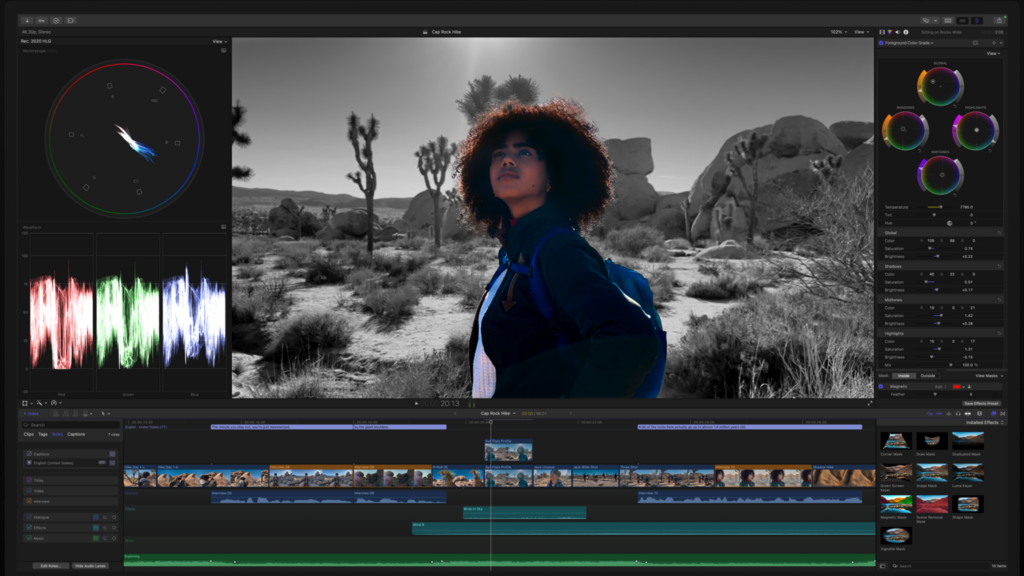FINAL CUT PRO FOR WINDOWS

WHAT IS FINAL CUT PRO?
FCP is a professional video editing app for Apple macOS and iPadOS.
It is known for its simple and straightforward workflow powered by advanced video editing tools that let content creators, video editors, and brands tell their stories; with precision and perfection.
Coming from Apple’s desk:
“Final Cut Pro allows you to edit more complex projects and work with larger frame sizes, higher frame rates, and more effects — all at incredible speeds.”
In many cases, old iMovie users turn into new FCP users, since FCP inherits its design, functionality, and workflow from iMovie, which is also an Apple product but is available free of cost.

FINAL CUT PRO PC FEATURES
FCP harnesses Apple Silicon and its powerful metal engine, allowing users to edit more complex projects, and work with larger file sizes involving higher frame rates and multi-layer effects, at lightning-fast speeds.

This allows users to isolate people and objects from the background without needing a green screen. This tool uses AI to detect shapes and track their movements.

Automatically transcribe spoken audio into captions, using an Apple-trained AI language model.

Final Cut Pro’s color grading tools consist of a color inspector which comes with Color Wheels, Color Curves, and Hue/Saturation curves for seamless color adjustment in your projects.

Final Cut Pro allows users to import, edit, grade, and export unbelievably lifelike images with its High Dynamic Range capabilities. FCP also comes with a Color Conform* feature that lets users tone-map* video, still images, and Motion titles from HDR to SDR*.

In Final Cut Pro, users can import and edit Spatial videos from devices such as Apple Vision Pro, or iPhone 15 Pro or later. With this feature, you can add titles, use color grading tools, add layers of effects, and do a lot more to make your Spatial videos way more “special.” (iykyk).

Even though FCP is an Apple product, it still offers seamless integration with third-party apps such as Shutterstock, APM Music, and Frame.io. So, you can browse and use countless HDR pictures, import the best music for your visual content, and share projects seamlessly between teams for approval, critiques, and discussions.

Final Cut Pro allows users to create detail-rich visual effects using lighting filter libraries from Boris FX Continuum FCP 2021, build connected motion graphics and abstract particle universes with Yanobox Nodes, create kinetic logos without keyframing using Pixel Film Studios, and explore innumerable plug-ins from FXFactory.

FINAL CUT PRO SYSTEM REQUIREMENTS FOR WINDOWS
| Component | Requirement |
| Operating system | Windows 10, 11 – 64 Bit |
| Processor | Intel Core i5 4.10 GHZ or better AMD Ryzen 5 or better |
| RAM | 12 GB for installation At least 16 GB for 4K video editing |
| Free disk space | 10 GB for installation At least 20 GB for 4K editing and storage (Recommended: 100 GB free space) |
| Audio devices | Any standard device can work. |
| Graphics | Intel HD Graphics 5000 or later NVIDIA GeForce GTX 700 or later AMD Radeon R5 or later |
WHAT SETS FINAL CUT PRO APART?
Hands down, Apple Silicon is one of the finest hardware for video editing. Since Final Cut Pro is an Apple product, it is thoroughly optimized for delivering unbeatable performance on compatible Macs and iPads. And, while this is not the only reason for using FCP, it’s one that’s impossible to overlook.
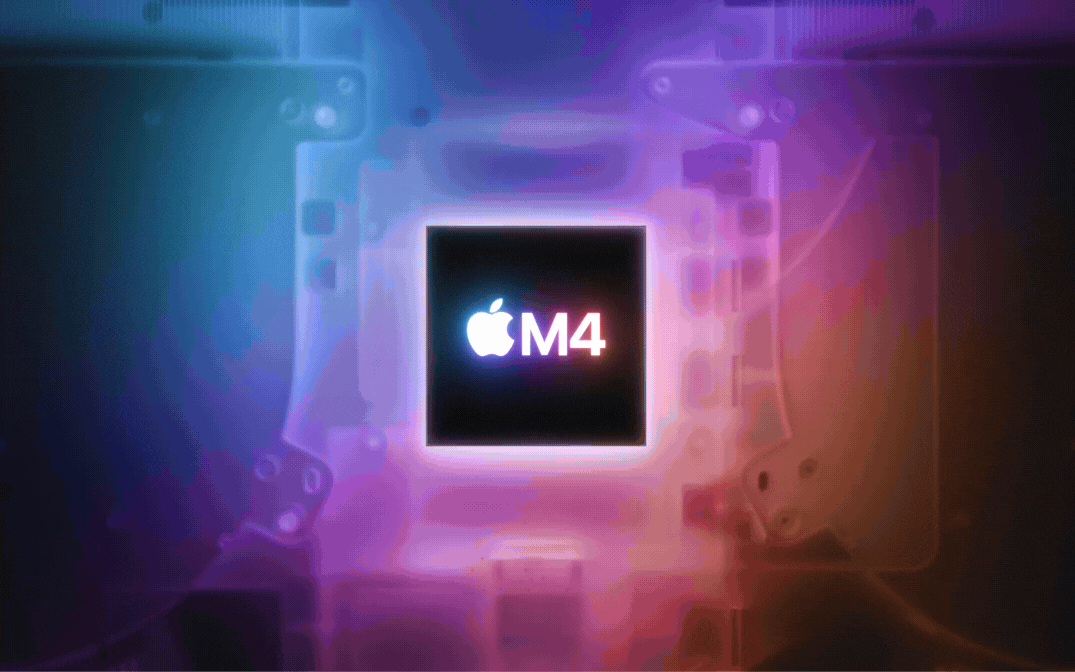
Oftentimes, we have heard new video editors complain about how difficult it is to edit videos with one tool or another. Some of these are popular tools that the entire editing community respects, but fears for their technical complexity.
On the other hand, Final Cut Pro is a simple tool with a straightforward workflow. It allows users to add layers of audio over their visual content, transcribe their spoken audio into captions, change the color space settings, and even create enormous particle universes, all too quickly and easily.

The Magnetic Timeline in FCP lets users move, arrange, split, and trim clips by just dragging. This reduces the need for additional buttons, since users can simply hold > drag > drop the clip, right where they want to.

Although stereoscopic anaglyph mode is not exclusive to FCP, it still makes it one of the few tools that offer it.
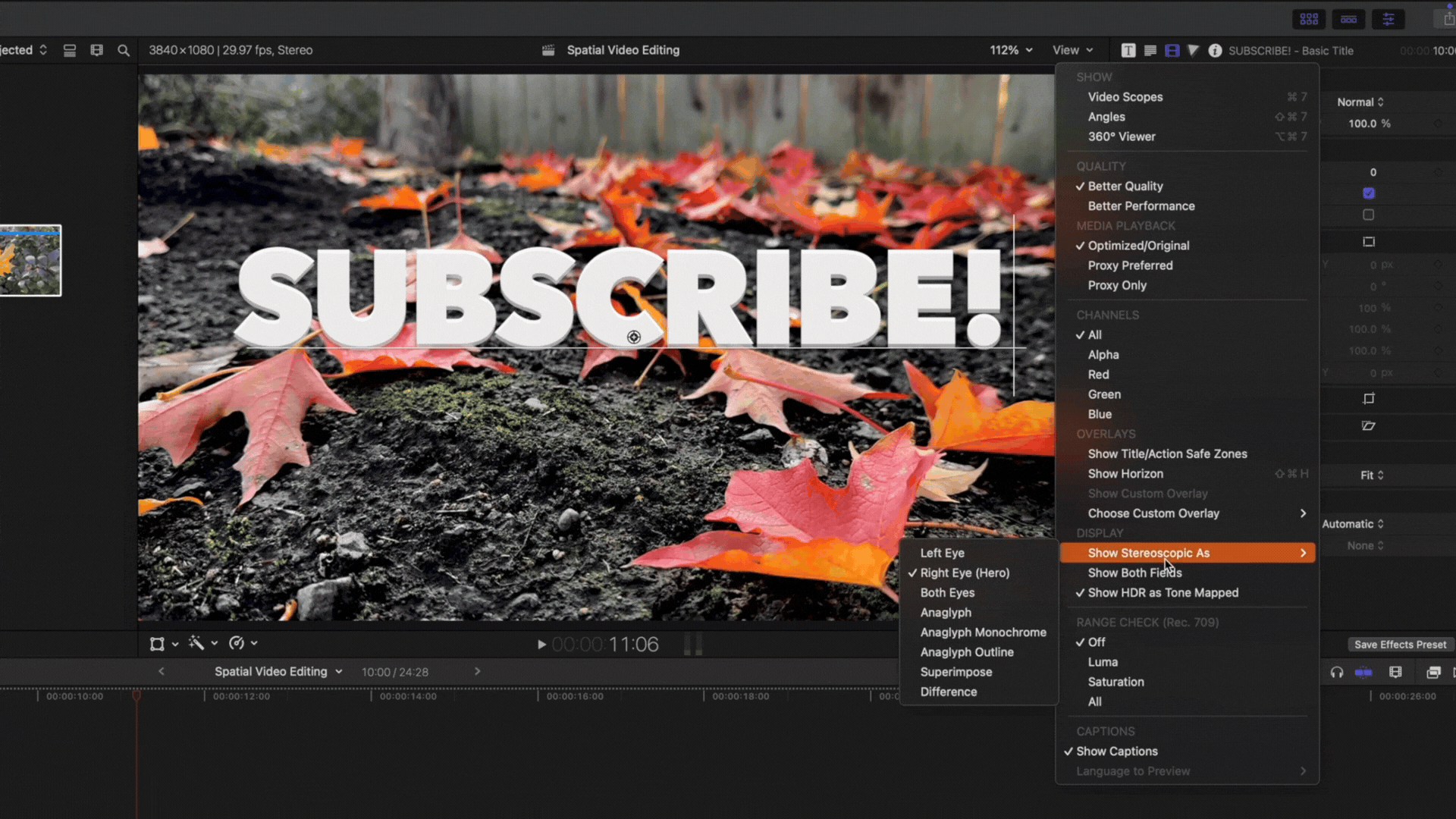
In Final Cut Pro’s recent update, Apple introduced the stereoscopic anaglyph* mode, allowing users to now edit spatial videos with precision, by viewing stereoscopic as:
- Difference
- Left eye
- Right eye (Hero Eye)
- Both eyes
- Anaglyph
- Anaglyph monochrome
- Anaglyph outline
- Superimpose
Although stereoscopic anaglyph mode is not exclusive to FCP, it still makes it one of the few tools that offer it.

In Final Cut Pro’s recent update, Apple introduced the stereoscopic anaglyph* mode, allowing users to now edit spatial videos with precision, by viewing stereoscopic as:
- Difference
- Left eye
- Right eye (Hero Eye)
- Both eyes
- Anaglyph
- Anaglyph monochrome
- Anaglyph outline
- Superimpose
Since Final Cut Pro is available on both Mac and iPad, users can import and export files between both devices. Final Cut Pro for iPad allows creators to make the most of Apple Pencil’s creative capabilities and FCP’s editing excellence. When these two are combined with Mac’s lightning-fast render speeds and limitless potential, editing becomes more productive and fun than ever before.
In Final Cut Pro, users can import and edit Spatial videos from devices such as Apple Vision Pro, or iPhone 15 Pro or later. With this feature, you can add titles, use color grading tools, add layers of effects, and do a lot more to make your Spatial videos way more “special.” (iykyk).

Even though FCP is an Apple product, it still offers seamless integration with third-party apps such as Shutterstock, APM Music, and Frame.io. So, you can browse and use countless HDR pictures, import the best music for your visual content, and share projects seamlessly between teams for approval, critiques, and discussions.

Final Cut Pro allows users to create detail-rich visual effects using lighting filter libraries from Boris FX Continuum FCP 2021, build connected motion graphics and abstract particle universes with Yanobox Nodes, create kinetic logos without keyframing using Pixel Film Studios, and explore innumerable plug-ins from FXFactory.

HOW TO INSTALL FINAL CUT PRO ON WINDOWS?
We can install Final Cut Pro on Windows by setting up a virtual macOS machine on your PC. In this case, we will be using Oracle VM VirtualBox to set up macOS on a Windows PC.
Here’s a step-by-step guide for installing FCP on your Windows PC.
Phase 1: macOS Setup
Step 1: Download the macOS ISO file from here. For this installation, we are using macOS Big Sur. You can decide which macOS version you wish to use.
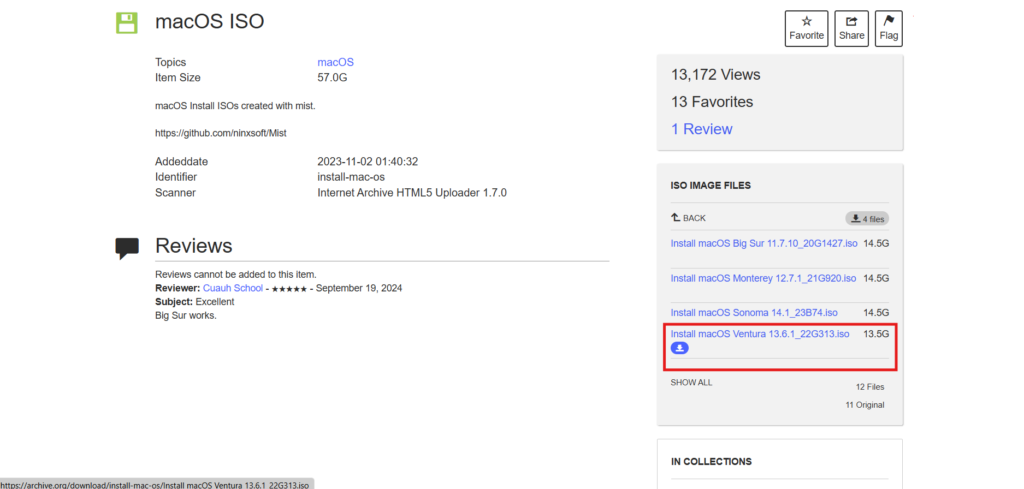
Step 2: Downloading VirtualBox
Visit the VirtualBox downloads page and click “Windows hosts” to start your download.
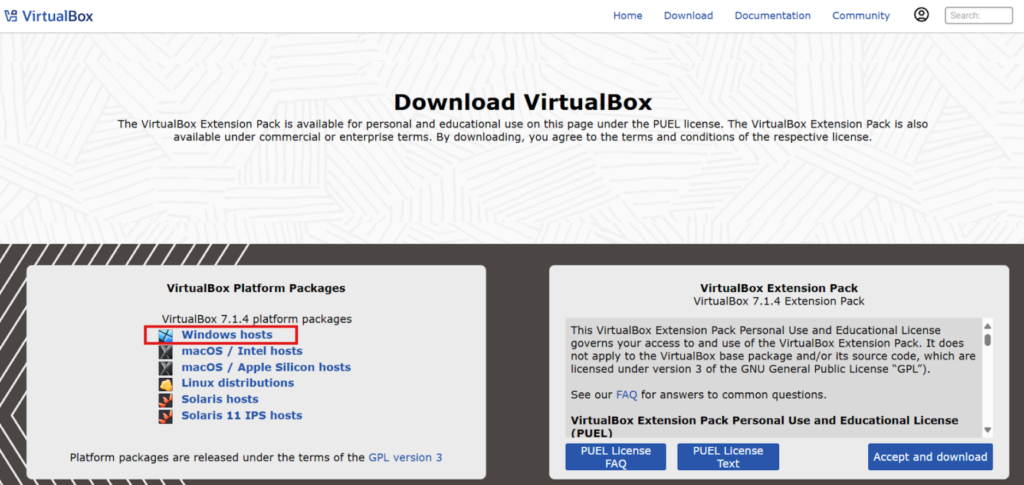
Step 3: Double-click the VirtualBox Installer and follow the on-screen instructions.
Step 4: Download the VirtualBox Extension Pack
Visit the VirtualBox downloads page and go to the VirtualBox Extension Pack box on the right.

Click “Accept and Download” to start your download.
Step 5: Launch the Extension Pack installer and follow the on-screen instructions.
Step 6: Disable Windows Hyper-V.
“Hyper-V is a Microsoft Virtualization software for Windows 10 and 11. While installing a virtual machine, we have to disable it to avoid conflict with our third-party virtualization tool(s).”
To disable Hyper-V:
- Type “Windows Security” in the search bar
- Open “Windows Security”
- Select “Device security”
- Click on “Core isolation details”
- Toggle off “Memory integrity”

Step 7: Complete the Hyper-V disable process
Right-click on the “Command Prompt” icon and click on “Run as administrator”
Type this code in Command Prompt and hit enter:
Bcdedit /set hypervisorlaunchtype off
Restart your computer to finish the Hyper-V disable process.
Step 8: Install macOS in VirtualBox
- Click on the “New” button
- Open Oracle VirtualBox
- Enter the name for this installation, pick your ISO image file, select Version as Mac OS X (64-bit), and click “Next.”
- After this step, allocate the storage space for your VM macOS (recommendable- at least 80 GB).
- Click “Finish.”
Step 9: Audio, Display, Wifi settings
- In the Oracle VirtualBox window, click on the “Settings” icon.
- Open the “System” tab
- Set the Chipset to ICH9 and enable EFI
- Go to Display settings, set Video Memory to 128 MB, and Enable 3D Acceleration
- Now, go to the “Network” tab > “Adapter 2” > “Enable Network Adapter” and select your adapter from the “Attached to” dropdown menu.
Step 10: Patch the Virtual Machine
- Depending on your processor (Intel or AMD), copy the patch code from this file to Notepad.
Find “VM Name” with Ctrl+H and replace it with the name you’ve given to your OS in step 8. - Close VirtualBox and run Command Prompt as administrator.
- Enter these commands in the Command Prompt
Step 11: Install macOS into the Virtual Machine
- Click “Start” to start your VM macOS
- A script will start running, after which, we’ll be ready to move ahead
Step 12: Format the Virtual Drive
- After the previous steps, macOS will start booting
- Select your preferred language and click on “Disk Utility.”
- Select VBOX HARDDISK Media and click on the erase button in the top bar
- Now rename the drive and Erase it
- Close Disk Utility, and click to Install macOS
- Follow the on-screen instructions
- Select the Disk and click Continue
- The installation process will start and later the macOS will start loading up.
This process can take 30 to 50 minutes to complete- depending on your system and processor.
After the installation, your macOS VM will start. From here you can set up your VM macOS and log in using your existing Apple ID or create a new one.
Phase 2: Download Final Cut Pro
Once you are logged in, you can open Safari and download Final Cut Pro’s 90-day free trial DMG from Apple’s official website.
After downloading the DMG, double-click on it, and follow the on-screen instructions to install FCP.
FINAL CUT PRO ALTERNATIVES FOR WINDOWS
DaVinci Resolve is one of the most popular alternatives to Final Cut Pro. Stuffed with tons of features and functionalities, DaVinci is a complete package that reeks excellence like no other tool. Yes, it is more capable than FCP. However, this level of perfection brings in a great level of complexity. The tool encourages users to get into the minute details even while performing simple edits, which can be useful in Hollywood post-production projects, but, may be overwhelming while creating content for YouTube or social media.

If you are starting off your video editing journey and are passionate to take on challenges- Resolve is the tool for you. This comes with traditional video editing setups, which have been further simplified in FCP. As a result, if you only use FCP, you may always be scared of using DaVinci, while, after mastering DaVinci, FCP will look like a cakewalk.
Adobe Premiere Pro is a simple and straightforward tool that allows you to easily edit and create production-quality videos. In features and capabilities, it stands nearly equal to Final Cut Pro. However, its cross-platform availability makes it more accessible than FCP, which is why, it can be a great alternative to Final Cut Pro, at least on Windows.

Adobe offers Premiere Pro’s monthly subscription at a cost of $20.9/month. While FCP comes at a one-time cost of $299.99.
The pricing makes Premiere Pro more suitable for editors who may not need the tool at all times in their careers. While FCP’s one-time cost makes it a more reasonable investment in the long run.
“Pro-caliber editing power that doesn’t break the bank.”
This is what Pinnacle Studio’s website says, and this is what is true about the tool. It’s a complete package that allows users to edit visual content with professional detailing but costs less than DaVinci, Final Cut Pro, or Adobe Premiere Pro. The full Pinnacle Studio 26 Ultimate suit comes at a price of $129.99, with floating discounts on Cyber Mondays and Black Fridays (around these times, you can save another $50).

This tool is exclusive to Windows PCs, which makes it a great alternative to FCP. If you are starting your video editing journey and want a tool that’s less overwhelming and more functional, Pinnacle Studio can be your best bet.
Although stereoscopic anaglyph mode is not exclusive to FCP, it still makes it one of the few tools that offer it.

In Final Cut Pro’s recent update, Apple introduced the stereoscopic anaglyph* mode, allowing users to now edit spatial videos with precision, by viewing stereoscopic as:
- Difference
- Left eye
- Right eye (Hero Eye)
- Both eyes
- Anaglyph
- Anaglyph monochrome
- Anaglyph outline
- Superimpose
Although stereoscopic anaglyph mode is not exclusive to FCP, it still makes it one of the few tools that offer it.

In Final Cut Pro’s recent update, Apple introduced the stereoscopic anaglyph* mode, allowing users to now edit spatial videos with precision, by viewing stereoscopic as:
- Difference
- Left eye
- Right eye (Hero Eye)
- Both eyes
- Anaglyph
- Anaglyph monochrome
- Anaglyph outline
- Superimpose
Since Final Cut Pro is available on both Mac and iPad, users can import and export files between both devices. Final Cut Pro for iPad allows creators to make the most of Apple Pencil’s creative capabilities and FCP’s editing excellence. When these two are combined with Mac’s lightning-fast render speeds and limitless potential, editing becomes more productive and fun than ever before.
In Final Cut Pro, users can import and edit Spatial videos from devices such as Apple Vision Pro, or iPhone 15 Pro or later. With this feature, you can add titles, use color grading tools, add layers of effects, and do a lot more to make your Spatial videos way more “special.” (iykyk).

Even though FCP is an Apple product, it still offers seamless integration with third-party apps such as Shutterstock, APM Music, and Frame.io. So, you can browse and use countless HDR pictures, import the best music for your visual content, and share projects seamlessly between teams for approval, critiques, and discussions.

Final Cut Pro allows users to create detail-rich visual effects using lighting filter libraries from Boris FX Continuum FCP 2021, build connected motion graphics and abstract particle universes with Yanobox Nodes, create kinetic logos without keyframing using Pixel Film Studios, and explore innumerable plug-ins from FXFactory.

FREQUENTLY ASKED QUESTIONS
For Mac users in the US, Final Cut Pro costs $299.99 and comes with a 90-day Free version. On the other hand, Final Cut Pro for iPad comes with a one-month free trial and costs $4.99 monthly or $49 yearly after that.
Final Cut Pro is a comprehensive video editing software that comes with a wide range of advanced features. With basic video editing knowledge users can create great quality videos using FCP. However, to get the most out of it, users may need to get familiar with the crucial concepts of video editing- which we have covered in a detailed article.
Apple does not sell Final Cut Pro for Windows PCs. Users can use Final Cut Pro on Windows by installing:
- Cloud Mac
- VMWare
- Virtual Machine
GLOSSARY
Tone mapping is the process of adjusting high dynamic range (HDR) content to play on displays that do not present the full range of colors, brightness, and contrast in an HDR visual.ab 1 content.
Stereoscopy is the process by which two pictures of the same object are taken at slightly different angles and viewed together, creating an impression of depth and solidity.
An anaglyph is a stereoscopic picture with two images superimposed over each other and shown in different colors- usually red and green. This is especially useful where precise depth and perception have to be presented, such as in spatial videos.
Final Cut Pro’s color conform feature automatically converts the newly added clip’s color space settings to match those of the project it is added to.
SDR stands for Standard Dynamic Range, which is a current standard for video and cinema displays. SDR can only present a fraction of the brightness and contrast ranges that HDR presents.
SDR stands for Standard Dynamic Range, which is a current standard for video and cinema displays. SDR can only present a fraction of the brightness and contrast ranges that HDR presents.
